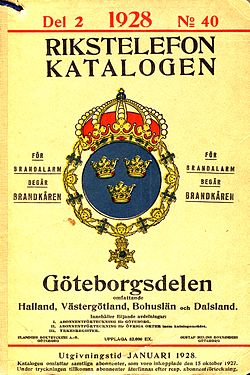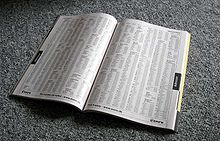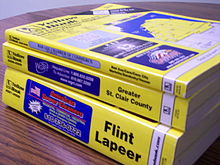- Telephone directory
-
"Phone book" and "White pages" redirect here. For a contact list, see Contact list. For other uses, see White pages (disambiguation).
A telephone directory (also called a telephone book, phone book and white/yellow pages) is a listing of telephone subscribers in a geographical area or subscribers to services provided by the organization that publishes the directory. Its purpose is to allow the telephone number of a subscriber identified by name and address to be found.
Contents
Content
Subscriber names are generally listed in alphabetical order, together with their postal or street address and telephone number. In principle every subscriber in the geographical coverage area is listed, but subscribers may request the exclusion of their number from the directory, often for a fee; their number is then said to be "unlisted" (American English), "ex-directory" (British English) or "private" (Australia and New Zealand).[citation needed]
A telephone directory may also provide instructions about how to use the telephone service in the local area, may give important numbers for emergency services, utilities, hospitals, doctors and organizations who can provide support in times of crisis. It may also have civil defense or emergency management information. There may be transit maps, postal code guides, or stadium seating charts, as well as advertising.
In the US, under current rules and practices, mobile phone and Voice over IP listings are not included in telephone directories. Efforts to create cellular directories have met stiff opposition from several fronts, including those who seek to avoid telemarketers.[citation needed]
Types
A telephone directory and its content may be known by the color of the paper it is printed on.
- White pages generally indicates personal or alphabetic listings. Telephone directories using the name "White Pages" exist in 91 different countries.[1]
- Yellow pages, golden pages, A2Z, or classified directory is usually a "business directory," where businesses are listed alphabetically within each of many classifications (e.g., "plumbers"), almost always with paid advertising.
- Gray pages, sometimes called a "reverse telephone directory," allowing subscriber details to be found for a given number. Not available in all jurisdictions for reasons of privacy.
Other colors may have other meanings; for example, information on government agencies is often printed on blue or green pages.[citation needed]
Publication
Telephone directories can be published in hard copy or in electronic form. In the latter case, the directory can be provided as an online service through proprietary terminals or over the Internet, or on physical media such as CD-ROM. In many countries directories are both published in book for and also available over the Internet. Printed directories were usually supplied free of charge before online access was available; more recently there is often a charge,[citation needed] although subscribers are not obliged to buy a printed directory.
In France, the Minitel videotex system originated as an attempt by France Télécom to rid itself of its paper publishing costs by renting a Minitel terminal to all telephone users. However, France Télécom continues to give hard copies to its subscribers.
In Switzerland, most pay phones are now accompanied with electronic telephone directory terminals instead of paper directories,[citation needed] and phone users are charged for each search.
History
The first telephone directory, consisting of a single piece of cardboard, was issued on February 21, 1878; it listed 50 businesses in New Haven, Connecticut that had a telephone.[2]
The first British telephone directory was published on 15 January 1880 (the year after a public telephone service was introduced into the UK) by The Telephone Company. It contained 248 names and addresses of individuals and businesses in London; telephone numbers were not used at the time as subscribers were asked for by name at the exchange.[3] The directory is preserved as part of the British phone book collection by BT Archives.
The Reuben H. Donnelly company asserts[citation needed] that it published the first classified directory, or yellow pages, for Chicago, Illinois, in 1886.
In 1981 France is the first country to have an Electronic Directory[4] on a prehistoric Internet system called Minitel. The Directory is called "11" after its telephone access number.
In 1991 the U.S. Supreme Court ruled (in Feist v. Rural) that telephone companies do not have a copyright on telephone listings, because copyright protects creativity and not the mere labor of collecting existing information. Within the geographical reach of the Court, the Feist ruling has resulted in the availability of various telephone directory services on CD-ROM and the World Wide Web.[citation needed]
1994 is the year the first Telephone Directories go online in Australia. Yellowpages.com.au is the fist one soon followed by Whitepages.com.au both operated by the Australian Phone company Telstra [5]
1996 is the year the first Telephone Directories go online in the USA. Yellowpages.com and Whitepages.com, both see their start in april[6]. While Yellowpages.com is now part of AT&T, Whitepages.com is still owned by Alex Algard, its original founder[7].
In other countries Online Directories start at a little later. In France the first Directory Pageszoom.com, later rebranded as Pagesjaunes.fr goes online in 1997. English Whitepages.fr only arrive in may 2004. In Italy Paginebianche.it start in 1999 - English Whitepages.it only arrive in july 2004.
Reverse directories
A reverse telephone directory is sorted by number, which can be looked up to give the name and address of the subscriber. Reverse telephone directories are used by law enforcement and other emergency services in order to determine the origin of any request for assistance. These systems include both publicly accessible (listed) and private (unlisted) services. As such, these directories are restricted to internal use only. Publicly accessible reverse telephone directories are provided as part of the standard directory services from the telecommunications carrier in some countries.
Phone books in popular culture
Ripping phone books in half has often been considered a feat of strength. The Guinness World Record for ripping the most telephone directories is 27 and then French telephone directories is 29 held by Georges Christen.
- In the show MythBusters on the Discovery Channel, Adam Savage and Jamie Hyneman tried to separate two phone books with the pages interlaced with each other. Most viewers assume that the two phone books used are regular San Francisco area Yellow Pages. The myth states that two phone books with interlaced pages cannot be pulled apart. After using themselves in a game of tug-o-war, two five-person tug-o-war teams, all 10 people vs. the anchored books, then two rental cars, they resorted to using two older American military vehicles, a tank and an armored personnel carrier. While the phone books were separated, the force gauge that was used recorded 8,000 pounds-force (36,000 N) of force when the interlacing failed. Savage explained that they would have been able to suspend the weight of the two rental cars they used earlier, using the interlaced phone books as the attaching point. The books stayed together due to the friction of the hundreds of pages rubbing against each other.
Phone books are used in multiple scenes of intimidation and impending death in HBO's popular crime-drama series, The Sopranos:
- In the episode, "College", Tony Soprano uses a pay phone telephone directory to locate wiseguy Fabian "Febby" Petrullio, who had turned State's Witness before being kicked out of the witness protection program, and assumed the name "Frederick 'Fred' Peters".
- In the episode, "Where's Johnny?", Phil Leotardo intimidates Lady Shylock, Lorraine Calluzzo, by having her tightly bound and gagged with duct tape, and shot at, using a telephone directory to stop the bullet.
- In "Pie-O-My", Adriana La Cerva witnesses Tony Soprano's men intimidating a man named Giovanni at the Crazy Horse nightclub, by hitting him about the head with a telephone directory.[8]
See also
References
- ^ - International List of all official Whitepages
- ^ Jason Zasky. "The Phone Book". Failure Magazine. http://failuremag.com/index.php/site/print/the_phone_book/. Retrieved 2011-09-22.
- ^ Records of the Telephone Company Limited (Bell's Patents), BT Archives reference TPA
- ^ Telephone History in France by Whitepages.fr
- ^ History of White and Yellowpages in Austrial
- ^ Telephone Directory History by Whitepages.fr
- ^ History of Whitepages.com
- ^ Maurice Yacowar. The Sopranos on the Couch: Analyzing Television's Greatest Series. p. 186. http://books.google.com/books?id=8vQxFWbD3aoC&pg=PA186&lpg=PA186&dq=the+sopranos+crazy+horse+club#v=onepage&q&f=false. Retrieved 2010-12-25.
Further reading
- Shea, Ammon (2010). The Phone Book: The Curious History of the Book That Everyone Uses But No One Reads. Perigee Trade. ISBN 978-0399535932.
Categories:- Telephone numbers
- Directories
- History of the telephone
Wikimedia Foundation. 2010.




